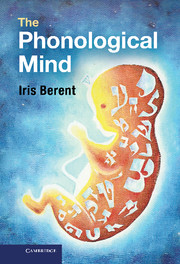Book contents
- Frontmatter
- Contents
- Figures
- Tables
- Copyright acknowledgements
- Preface
- Part I Introduction
- Part II Algebraic phonology
- Part III Universal design
- 6 Phonological universals
- 7 Phonological universals are mirrored in behavior
- 8 Phonological universals are core knowledge
- Part IV Ontogeny, phylogeny, phonological hardware, and technology
- References
- Index
7 - Phonological universals are mirrored in behavior
evidence from artificial language learning
Published online by Cambridge University Press: 05 February 2013
- Frontmatter
- Contents
- Figures
- Tables
- Copyright acknowledgements
- Preface
- Part I Introduction
- Part II Algebraic phonology
- Part III Universal design
- 6 Phonological universals
- 7 Phonological universals are mirrored in behavior
- 8 Phonological universals are core knowledge
- Part IV Ontogeny, phylogeny, phonological hardware, and technology
- References
- Index
Summary
The view of phonology as a system of core knowledge predicts that the grammars of all speakers include a common set of universal constraints. This chapter illustrates the use of experimental methods to test this hypothesis. The experiments reviewed here compare participants’ ability to learn structures that are universally marked to their ability to learn unmarked structures. As predicted, unmarked structures are learned more readily. Moreover, the advantage of unmarked structures obtains even when marked and unmarked structures are both absent in participants’ language. While these results reveal a strong correlation between typological regularities and the behavior of individual speakers, they leave open questions regarding its source – whether the convergence results from universal grammatical constraints or from non-grammatical origins. These findings underscore some of the difficult challenges facing the experimental study of grammatical universals.
The view of phonology as a system of core knowledge predicts that all grammars converge on a common design, defined by a universal set of primitives and constraints. The evidence reviewed in the previous chapter supported this hypothesis. We saw that diverse languages, signed and spoken, manifest some strong structural regularities that systematically favor certain linguistic structures over others. We further showed how these cross-linguistic regularities (and variations) might emerge from the ranking of universal grammatical constraints. The universal grammar hypothesis, however, is not limited to an account of typological regularities. Indeed, the very same grammatical forces that shape the language typology are presumably active in the brains and minds of living breathing speakers. This strong hypothesis makes some interesting predictions that are amply amenable to experimental investigation. If this hypothesis is correct, then one would expect the behavior of individual speakers to mirror typological regularities: Unmarked phonological structures should be preferred to their marked counterparts. And if the preference for unmarked structures is universally active, then the preference for unmarked structures should be seen across all speakers, even if the structures under consideration are absent in their language.
- Type
- Chapter
- Information
- The Phonological Mind , pp. 149 - 164Publisher: Cambridge University PressPrint publication year: 2013



